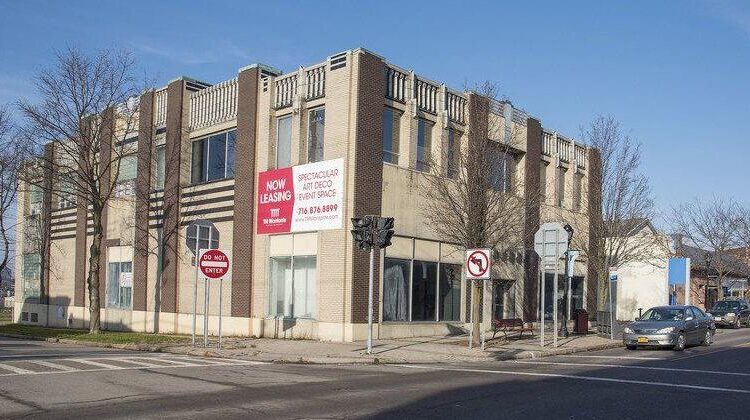
State auditors have taken a Niagara Falls-based development agency to task for failing to provide specific details about potential economic benefits from some of its real estate transactions, including the $1.36 million purchase of seven downtown properties that were later sold to private developers for $3.
In an audit released Wednesday, New York State Comptroller Thomas DiNapoli’s office determined that while USA Niagara Development Corp.’s real estate deals complied with requirements under New York’s Public Authorities Law, they were approved with “insufficient” information about the number and types of jobs to be created and potential tax ramifications compared to the value received and the properties’ fair market value.
The findings were part of a broader audit by the state comptroller that determined USA Niagara’s parent agency, the Empire State Development Corp., failed to meet statutory requirements to provide accurate, annual reports of its real estate holdings.
“ESD has to be more transparent about the real estate transactions it makes,” DiNapoli said. “That should start with an accurate accounting of its real estate portfolio and better disclosure explaining the economic benefits to New York’s taxpayers for sales of properties below their fair market value.”
Empire State Development responds
In response to the audit, ESD defended the real estate deals, arguing that they were made in keeping with USA Niagara’s core mission, which is to return long-dormant properties in the Falls to productive use through partnerships with the private sector.
ESD noted that the properties were part of USA Niagara’s “strategic land acquisition,” which was funded under former Gov. Andrew Cuomo’s “Buffalo Billions” economic development initiative to “assemble long-dormant properties located near Niagara Falls State Park to remove blight from the downtown area and expand the density of uses there toward the establishment of a year-round, sustainable neighborhood.”
“This mission was accomplished by acquiring these vacant, underutilized and blighted properties and transferring them to developers to densify and revitalize an important commercial corridor in Niagara Falls,” ESD said in its audit response.
ESD also argued that the board materials for each of the projects described the main goal while setting forth the additional, ancillary benefits of the projects.
“All of the transfers of properties were conducted in compliance with the law,” ESD spokesperson Pamm Lent said in a statement issued in response to questions from the newspaper. “Forecasting future increased tax revenue or job creation were not requirements of the transfer.”
USA Niagara is a public benefit corporation formed in 2001 under the administration of former Gov. George Pataki. The ESD subsidiary is charged with supporting and promoting economic development initiatives in Niagara Falls by “leveraging private investment and encouraging growth and renewal of the tourism industry” in the city.
Properties in question
In 2019, USA Niagara’s board of directors agreed to buy 31 individual properties totaling about 11 acres of land in downtown Niagara Falls from its owner at the time, Lewiston businessman Joseph “Smokin’ Joe” Anderson. The agency acquired the parcels using $14.7 million in state funds from former Gov. Andrew Cuomo’s Buffalo Billions economic development initiative. At the time, state officials said the parcels had a total fair market value of $25.75 million.
USA Niagara acquired Anderson’s properties, which had been inactive for years, for the purposes of making them available to new owners that expressed interest in redeveloping them, preferably as part of mixed-use projects.
State auditors noted that, as of June 2023, the state agency disposed of seven of those properties, which they said were acquired at a total cost of $1.36 million and later sold to a trio of developers who paid $1 apiece, or $3 in total.
Of the properties, four, with addresses at 500, 512, 518 and 503 Third St., were transferred in March 2021 by USA Niagara’s board for $1 to Montante Group, LLC, a division of the Western New York development firm TM Montante.
USA Niagara selected Montante as the preferred developer of the parcels in January 2020 following the release of a request for proposals seeking interested developers. Montante initially announced plans to develop a brewery, office and events space at 500 Third St. The company has since announced a partnership with Rochester-based Radio Social to develop restaurants, bars, a boutique hotel, conference space and a bowling alley at 500 Third St. and 512 Third St.
TM Montante President Chris Campos told the newspaper earlier this month that the company remains committed to the project, which he described as delayed due to financing.
USA Niagara transferred the Third Street properties to Montante at the same time board members agreed to transfer two other parcels, vacant lots at 554 and 558 Third St., for $1 to another private company, SJI Main. Those lots were made available by the agency for use as parking space in support of SJI Main’s plan to build a large-scale apartment complex that would include 36 residential apartments and six commercial spaces.
The seventh property identified in the audit, which is located at 466 Third St., features two first-floor commercial spaces, including one currently leased by local pizzeria Donatallo’s Restaurant and the Hammer & Crown Brewing Co., which is continuing to work on the opening of a brewery on site. USA Niagara sold that property to a local firm, Cataract Development Corp., for $1 to support the company’s now-completed refurbishment of eight upstairs apartments.
Audit raises questions
Auditors noted that Public Authorities Law requires public authorities to dispose of properties for fair market value, with exceptions. When proposing below-market transfers, auditors noted that authorities must provide detailed information to their boards and the public, including a description of the property; an appraisal of the fair market value of the property; a description of the purpose of the transfer; and a reasonable statement of the kind and amount of the benefit to the public resulting from the transfer.
In USA Niagara’s case, auditors found the agency’s board was presented with “only general statements and information on the benefits of the proposed projects.” While expected benefits for the redevelopment projects tied to the seven properties in question were listed as the creation of new jobs or increases in tax base, auditors said USA Niagara staffers did not provide any specific information on the number of jobs and types of jobs that would result from the projects, nor did they provide specific information, or a range, of how much tax revenue the locality might expect once the projects were completed.
“For each of these disposals, USAN presented the information that complied with the minimum requirements of the (Public Authorities Law) to its board for approval,” the state audit reads. “However, the information presented lacked detail to more effectively evaluate the transactions prior to their approval beyond broad generalizations about new developments.”
According to the audit, ESD reported that as of June 2023, it owned 130 properties and that 71 (55%) are vacant. Three of the vacant properties are former correctional facilities in the New York City area (Downstate, Bayview, and Lincoln). ESD identified those properties as having potential for conversion to housing (including affordable housing) and issued requests for proposals for them.
Another 28 vacant properties, according to the audit, are in and around Niagara Falls and are owned by USA Niagara. Auditors found only one of those properties is reported by ESD to have “definitive” development plans.
In response to the audit, ESD suggested the comptroller’s office “incorrectly” described the 28 vacant parcels as lacking “definitive” development plans. State officials noted that the 28 properties are part of a larger investment in the Falls to “remove blight from the area and support neighborhoods.” They also indicated that there are 28 separate tax parcels that are not “independent properties appropriate for separate development opportunities.”
Of the properties, ESD said nine were subject to a request for proposals and have a preferred developer as part of a planned development, five will be used as part of a public plaza project tied to USA Niagara’s Heritage Gateway and two will be subject of a future RFP for private development following completion of the gateway. ESD also noted that the remaining properties were subject to RFPs that either failed to garner acceptable development proposals or were not yet connected to signed development agreements.
The state audit also took ESD to task for failing to adhere to a section of Public Authorities Law that requires the publication, at least annually, of a report listing all real property it holds as well as full descriptions of properties that it either sold or transferred.
DiNapoli’s office determined that ESD only published a detailed report on its real estate portfolio in December 2022 after the current audit began. Before that report was published, ESD had provided auditors with five inaccurate or incomplete versions of its property portfolio. Those repeated inaccuracies raise concerns that the published report may still not correctly account for ESD’s holdings or their disposal.
Auditors recommended ESD officials take steps to ensure the accuracy of the agency’s reports on its real estate portfolio and its disposal of properties and suggested the agency provide “sufficiently detailed information for proposed transfers of properties, especially those below fair market value.”
In response, ESD officials stated they established new management of its real estate holdings and said it initiated quarterly meetings regarding the properties and their disposition.
